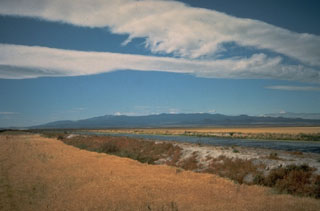Report on Medicine Lake (United States) — October 1988
Scientific Event Alert Network Bulletin, vol. 13, no. 10 (October 1988)
Managing Editor: Lindsay McClelland.
Medicine Lake (United States) Occasional seismicity; caldera subsides
Please cite this report as:
Global Volcanism Program, 1988. Report on Medicine Lake (United States) (McClelland, L., ed.). Scientific Event Alert Network Bulletin, 13:10. Smithsonian Institution. https://doi.org/10.5479/si.GVP.SEAN198810-323020
Medicine Lake
United States
41.611°N, 121.554°W; summit elev. 2412 m
All times are local (unless otherwise noted)
"Seismicity... continued sporadically throughout October. As of 15 November, seismicity had declined to several locatable events/week. Most were of M less than 1 with the exception of a M 2 event on 29 October. The installation of a tightly spaced seismic network on 22 October permits even small events to be located. Three well-constrained earthquakes have been located since 29 October in the E, central, and S portions of Medicine Lake glass flow in the NW part of the caldera (figure 1). Depths of recent events are shallow, between 0.5 and 1.5 km. The locations of the recent events show a northward shift from those of the late September swarm. Seismologists are uncertain whether this shift is real or the result of improved locations from the new network."
A levelling line (~16 benchmarks spaced 1.5-2.25 km apart along the main caldera access road through the W, center, and SE portions of the caldera) was reoccupied on three occasions. Relative to a 1954 National Geodetic Survey, August 1988 measurements showed 175 ± 11 mm of central caldera subsidence with respect to the W and S rims, although subsidence extended outside the caldera. An October 1988 survey indicated 8 ± 5 mm of additional subsidence which is within 2-3 standard errors of noise levels. However, the shapes of the long- and short-term deformation curves are similar, with maximum subsidence occurring at the central caldera benchmark, suggesting to geologists that the deformation is real. The line will be relevelled in the spring when snow conditions permit.
Geological Summary. Medicine Lake is a large Pleistocene-to-Holocene, basaltic-to-rhyolitic shield volcano east of the main axis of the Cascade Range. Volcanism, similar in style to that of Newberry volcano in Oregon, began less than one million years ago. A roughly 7 x 12 km caldera truncating the summit contains a lake that gives the volcano its name. A series of young eruptions lasting a few hundred years began about 10,500 years before present (BP) and produced 5 km3 of basaltic lava. Nine Holocene eruptions clustered during three eruptive episodes at about 5000, 3000, and 1000 years ago produced a chemically varied group of basaltic lava flows from flank vents and silicic obsidian flows from vents within the caldera and on the upper flanks. The last eruption produced the massive Glass Mountain obsidian flow on the E flank about 900 years BP. Lava Beds National Monument on the N flank of Medicine Lake shield volcano contains hundreds of lava-tube caves displaying a variety of spectacular lava-flow features, most of which are found in the voluminous Mammoth Crater lava flow, which extends in several lobes up to 24 km from the vent.
Information Contacts: S. Walter, USGS Menlo Park; D. Dzurisin, CVO.

